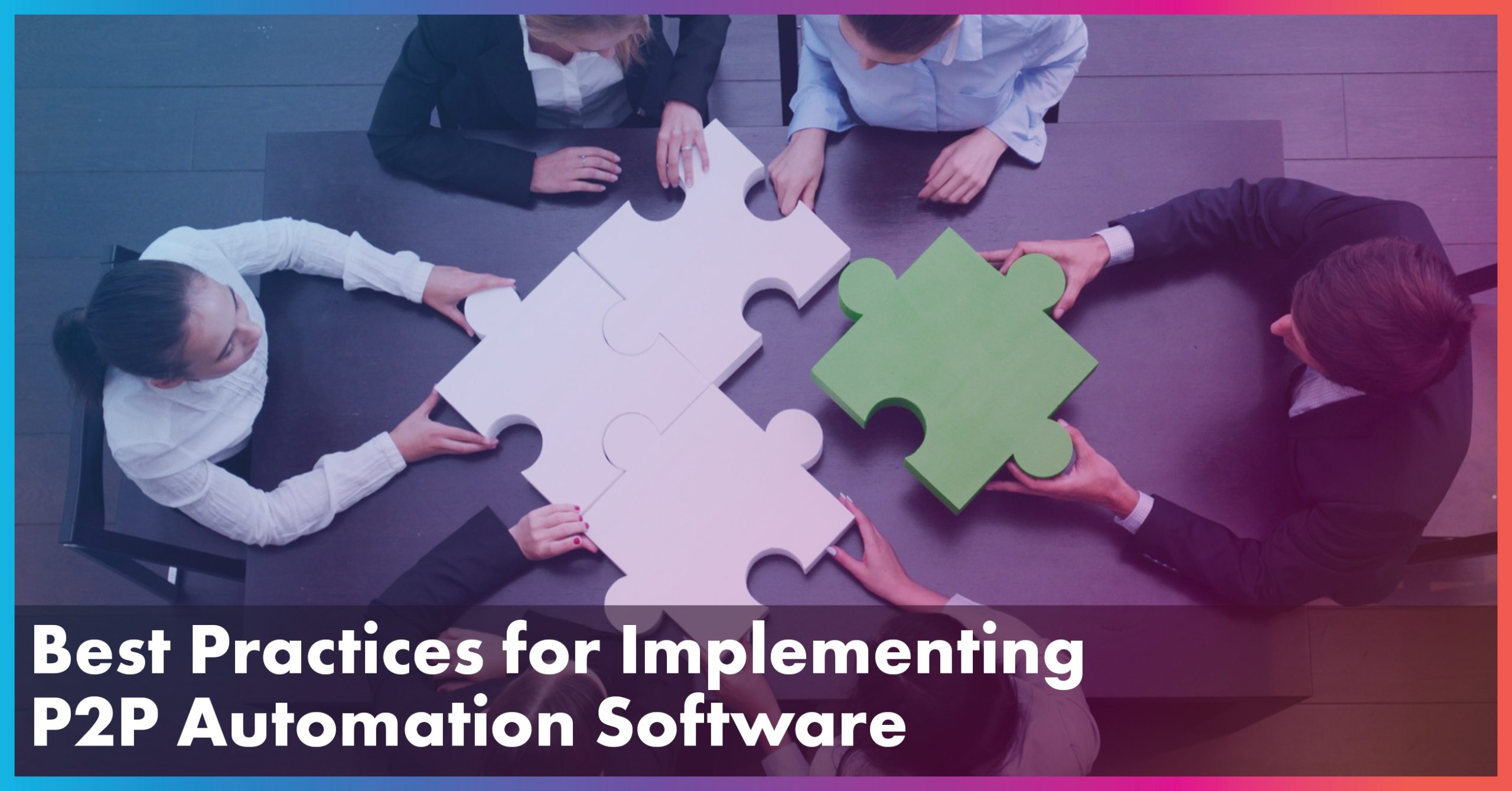Best Practices for Implementing P2P Automation Software
Posted On: May 30, 2023
Procure to Pay(P2P) is perhaps the first thing that comes to our mind when we hear procurement efficiency. It signifies the synergy between the accounts payable and purchasing teams of a company, working together to make procuring goods and services easy while ensuring transparency and control over processes. It plays a pivotal role in strengthening the procurement system within the company. Automation of P2P refers to the application of technology which takes efficiency to greater levels to streamline and expedite various processes such as ordering goods and services, managing invoices and making payments.
Index:
By adopting P2P automation organizations can simplify their procurement processes, reduce mistakes, and gain insights into their cash flow and spending patterns ensuring timely procurement and sustained operations. To achieve this organizations must adopt top procurement software or the best procurement automation tools available in the market which would provide complete solutions for running the whole procurement life cycle and enhancing efficiency.
Best Practices in P2P Automation
Additionally, companies must follow some best practices to effectively reap the benefits of P2P automation:
Adopt a comprehensive path:
It is important to not look at procurement automation tools in isolation. Instead, take a holistic approach by integrating it with other systems used within the organization. Choose a software that can effortlessly integrate with your existing ERP and other key systems. This ensures maximum benefits and seamless operations across various departments. Also, integrating procurement automation tools with other software ensures visibility into vendor performance, inventory levels, financial data, etc. helping companies to make better decisions.
Involve stakeholders from the start:
For a successful implementation of procurement automation tools, it is essential to engage stakeholders from various departments including finance, IT, procurement, operations, etc. from the beginning of the execution process. By including these stakeholders, companies can leverage their expertise and insights to structure procurement strategies effectively. This kind of collaborative outlook enables the selection of suitable automation solutions and allows for customization to meet the requirements.
Leverage the power of data analytics and reporting:
To get the best out of procurement automation tools, it is important to choose the top procurement software that can provide outstanding features in data analytics and reporting. Leveraging these capabilities will ensure the extraction of valuable insights about spending patterns, cost savings, vendor performance or any other relevant metrics ensuring the companies identify areas that require improvement and make smart decisions that boost the organization’s efficiency and cost-effectiveness.
Keep your team trained and up-to-date:
Adopting a purchasing management system or procurement automation tools is an ongoing process that requires continuous training and adaptation. Discussing the recent developments in the field and conducting training sessions to keep the team updated are some measures that enable organizations to effectively navigate software updates, learn new features and adopt best practices to manage procurement automation tools. Additionally, these practices also foster an attitude of continuous improvement and learning in employees and maximize the benefits of procurement automation tools.
Encourage continuous improvement and embrace feedback:
When adopting procurement automation tools, it is essential to create an environment where the team feels motivated to contribute their ideas for improvement. Acknowledge their feedback and input and remain open to innovative ideas. This not just validates their suggestions but also encourages them to proactively participate in improving processes. The combination of adopting the best procurement software along with this collaborative approach ensures that organizations reach greater heights in procurement processes.
Regularly review your processes:
It is essential to gauge the organization’s processes against industry best practices and benchmarks to identify areas that need to be worked on. By conducting regular checks organizations can assess the efficiency of their procurement automation tools. This kind of assessment allows the companies to recognize inefficiencies which can then be addressed through various process improvements and utilizing the capacities of the procurement automation tools. Verify the accuracy of data and standardization: It is crucial to cleanse and consolidate the inputs to ensure consistency across the system of procurement automation tools. Establish clear guidelines for data entry and management. This step will ensure good efficiency of chosen procurement automation tools and improve data analysis and reporting capabilities leading to informed decision-making.
These are some of the best practices that will help you distinguish your P2P automation software implementation and maximize the advantages for your company. Adopting top procurement software or procurement automation tools will provide a wide array of benefits and optimize procurement processes. Additionally, top procurement software mostly integrates with other enterprise systems such as ERP thus enabling effortless data exchange. This will in turn help in eliminating tedious manual data entry, and reduce mistakes enhancing the overall efficiency of the organization’s processes. In summary, the effective utilization of even the best procurement software requires the adoption of some best practices, which will help companies to optimize their procurement operations and gain a competitive advantage in the marketplace.
Conclusion
In addition to the best practices mentioned, leveraging Partner Portal, which provides a top-notch vendor management system, can further optimize P2P automation. It provides real-time data, improves efficiency, monitors performance, strengthens relationships with vendors helping organizations make well-informed decisions.

FAQs-
- What is P2P Automation Software?
P2P (Procure-to-Pay) automation software is a technology-based software that builds a unified single-point platform for the entire P2P process. The software uses AI, ML, and RPA tools to harmonize and automate functions and bring efficiency to the process.
- What are the benefits of P2P automation?
P2P automation streamlines procurement processes. Through automation of manual and repetitive tasks, it improves accuracy. Efficiency and cost saving. It also facilitates faster transactions, improving overall financial management, compliance, and supplier relationships.
- How do you Automate P2P?
Automate P2P processes by integrating your systems with Partner Portal, a cloud-based vendor management system. It not only streamline the P2P process of an organization, it will also create a platform fostering efficient collaboration between vendors.